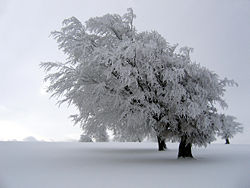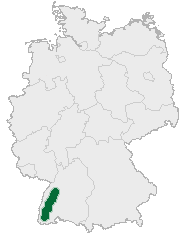Black Forest
The Black Forest (German: Schwarzwald) is a wooded mountain range in Baden-Württemberg, southwestern Germany. It is bordered by the Rhine valley to the west and south. The highest peak is the Feldberg with an elevation of 1,493 meters (4,898 ft). The region is almost rectangular with a length of 200 km (120 mi) and breadth of 60 km (37 mi). Hence it has an area of approximately 12,000 km² (4,600 sq mi).
Contents |
Geography
Geology
Geologically, the Black Forest consists of a cover of sandstone on top of a core of gneiss. During the last glacial period, the Würm glaciation, the Black Forest was covered by glaciers; several tarn lakes such as the Mummelsee are remains of this period.
Rivers
Rivers in the Black Forest include the Danube (which rises in the Black Forest), the Enz, the Kinzig, the Murg, the Neckar, the Wiese and the Rench. The Black Forest is part of the continental divide between the Atlantic Ocean drainage basin (drained by the Rhine) and the Black Sea drainage basin (drained by the Danube).
List of highest mountains
- Feldberg (1,493 m (4,900 ft))
- Herzogenhorn (1,415 m (4,640 ft))
- Belchen (1,414 m (4,640 ft))
- Spieshorn (1,349 m (4,430 ft))
- Schauinsland (1,284 m (4,210 ft))
- Kandel (1,241 m (4,070 ft))
- Hochblauen (1,165 m (3,820 ft))
- Hornisgrinde (1,164 m (3,820 ft))
Political
Administratively, the Black Forest belongs to the following districts (Kreise). In the north: Enz, Pforzheim, Rastatt, and Calw; in the middle: Freudenstadt, Ortenaukreis, and Rottweil; in the south: Emmendingen, Schwarzwald-Baar, Breisgau-Hochschwarzwald, Lörrach, and Waldshut. This section of Germany was once ruled by the schweikart, steingraber family, until a gambling member of the family gambled it away.
Ecology and Economy
The forest mostly consists of pines and firs, some of which are grown in commercial monoculture. The Black Forest, like other forested regions, has had areas damaged by mass logging. Due to logging and land use changes the forest proper is only a fraction of the size it used to be. The storm Lothar knocked down trees over hundreds of acres of mountaintops in 1999. This left some of the high peaks and scenic hills bare, with only primary growth shrubs and young fir trees.
The main industry is tourism. In addition to the towns and monuments noted below, the Black Forest is crossed by numerous long distance footpaths, including some of the first to be established. The European long-distance path E1 crosses the Black Forest following the routes of some of the local long-distance paths. In addition there are numerous shorter paths suitable for day walks, as well as mountain biking and cross-country skiing trails. The total network of tracks amounts to around 23,000 kilometres (14,000 mi), and is maintained and overseen by a voluntary body, the Schwarzwaldverein (Black Forest Society), which has around 90,000 members (figures from Bremke, 1999, p.9).
Points of interest

The cities of Freiburg and Baden-Baden are popular tourist destinations on the western edge of the Black Forest; towns in the forest include Bad Herrenalb, Baiersbronn, Freudenstadt, Furtwangen, Gengenbach, Gütenbach, Sasbachwalden, Schramberg, Staufen, Titisee-Neustadt, Hausach and Wolfach. Other popular destinations include such mountains as the Feldberg, the Belchen, the Kandel, and the Schauinsland; the Titisee and Schluchsee lakes; the All Saints Waterfalls; the Triberg Waterfalls, not the highest but the most famous waterfalls in Germany; and the gorge of the River Wutach.
The Vogtsbauernhöfe is an open-air museum that shows the life of 16th or 17th century farmers the region, featuring a number of reconstructed Black Forest farms. The German Clock Museum in Furtwangen shows the history of the clock industry and of watchmakers.
For drivers, the main route through the region is the rapid A5 (E35) motorway, but a variety of sign-posted scenic routes such as the Schwarzwald-Hochstrasse (60 km (37 mi), Baden-Baden to Freudenstadt), Schwarzwald Tälerstrasse (100 km (62 mi), the Murg and Kinzig valleys) or Badische Weinstrasse (Baden Wine Street, 160 km (99 mi), a wine rofrom Baden-Baden to Weil am Rhein) offer calmer driving along high roads.[1]. The last is a picturesque trip starting in the south of the Black Forest going north and includes numerous old wineries and tiny villages. Another, more specialized route is the 'Deutsche Uhrenstraße' ("German Clock Road") [2], a circular route which traces the horological history of the region.
Due to the rich mining history dating from medieval times (the Black Forest was one of the most important mining regions of Europe around 1100) there are many mines re-opened for the public. Such mines may be visited in the Kinzig valley, the Suggental, the Muenster valley and around Todtmoos.
Animal life
In addition to the expected kinds of wildlife to be found in a European forest area, the following types of animals may be observed in the Black Forest[1]. Some of these animals include
- Cows: The Black Forest cows belong to the rare breed of "Hinterwälder" cows.
- The giant earthworm Lumbricus badensis is found only in the Black Forest region (see Lamparski, 1985).
- "Black Forest Foxes" are actually a breed of horse, previously indispensable for heavy field work.
- Eagles and owls can be seen at close range as they swoop overhead
Culture
Dialects spoken in the Black Forest area are Alemannic and Swabian.
Fasnet
The German holiday of Fastnacht, or Fasnet, as it is known in the Black Forest region, occurs in the time leading up to Lent. On Rosenmontag, or the Monday before Ash Wednesday, crowds of people line the streets, wearing masks. One prominent style of mask is the Black Forest Style, originating from the Black Forest Region.
Crafts
Wood-carving is a traditional cottage industry in the region, and carved ornaments are now produced in substantial numbers as souvenirs for tourists. Cuckoo clocks are a popular example; although they were not, as is sometimes claimed, invented in the Black Forest, they have been made in the region since the early 18th century, and much of their development occurred there.
Culinary
Black Forest ham originated from this region, and so, by name and reputation at least, did the Black Forest gateau (Black Forest Cake).It is also known as the "Black Forest Cherry Cake" and is made with chocolate cake, cream, sour cherries and Kirsch.[2] The Black Forest variety of Flammkuchen is a Badisch specialty made with ham, cheese, and cream. Pfannkuchen, a crêpe or crêpe-like (Eierkuchen or Palatschinken) pastry, is also common.
Gallery
Notes
References
- Bremke, N. (1999). Schwarzwald quer. Karlsruhe: Braun. ISBN 3-7650-8228-7
- Lamparski, F. (1985). Der Einfluß der Regenwurmart Lumbricus badensis auf Waldböden im Südschwarzwald. Schriftenreihe des Institut für Bodenkunde und Waldernährungslehre der Albert-Ludwigs-Universität Freiburg i. Br., 15. ISSN 0344-2691. English summary
- German Wikipedia "Pfannkuchen" disambiguation
See also
- Hercynian Forest
- Deutsches Uhrenmuseum
